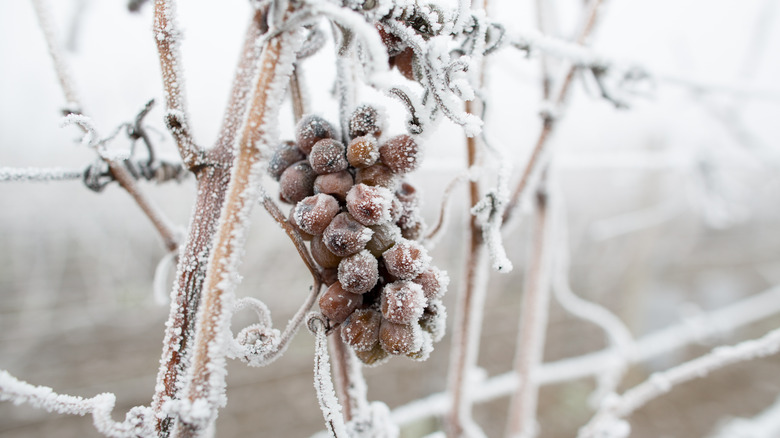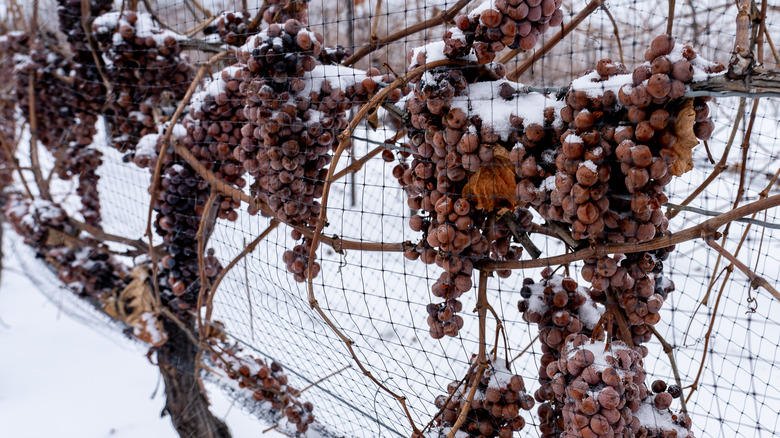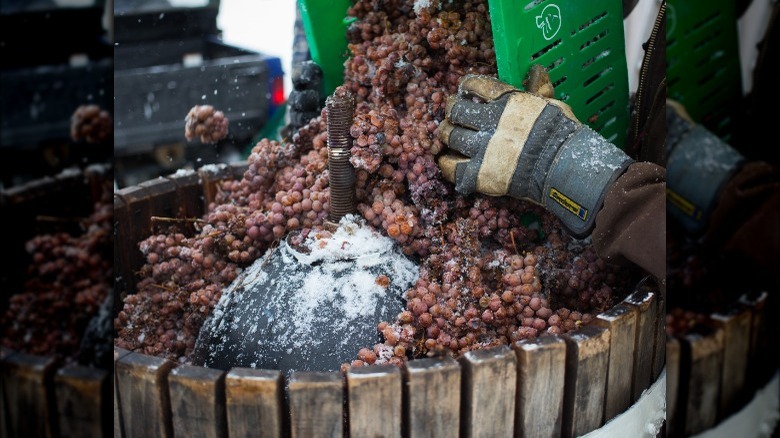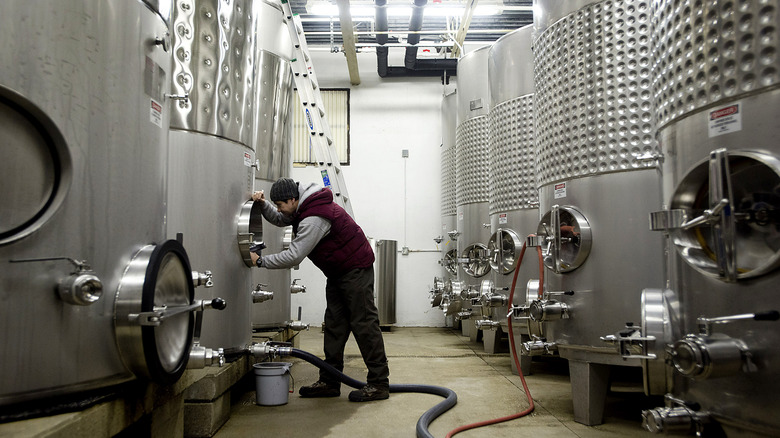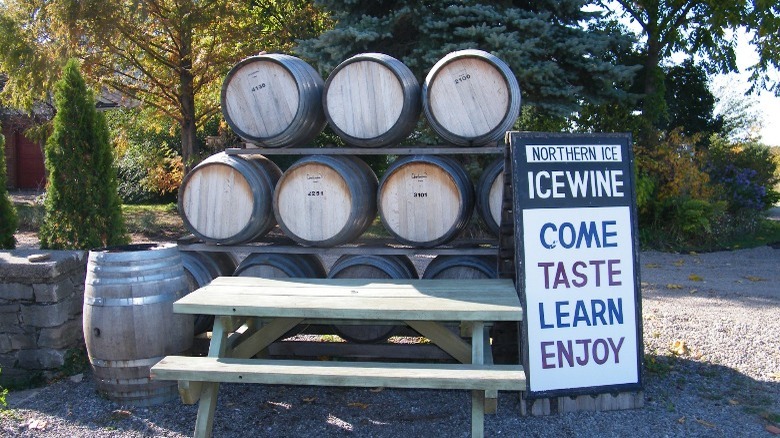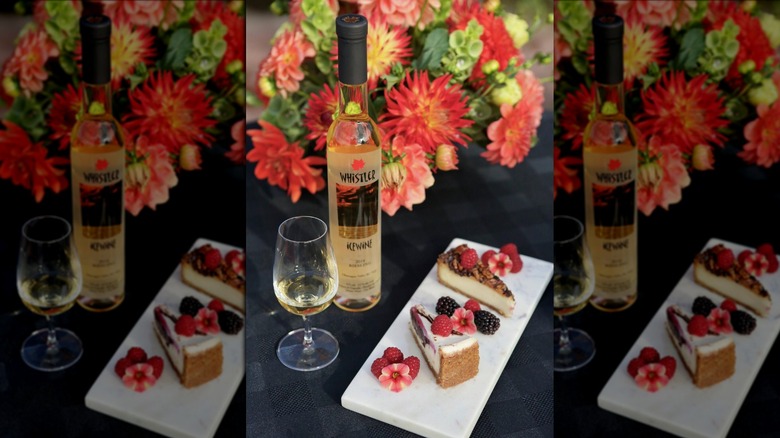Everything You Need To Know About Ice Wine
When people first start learning about wines, they start sorting them into reds and whites. Then to the different grape varieties in each category, like chardonnay, pinot grigio, Malbec, and the like. But often what gets overlooked is the category of dessert wines. As Wine Folly notes, there are traditionally five types of dessert wines: sparkling, lightly sweet, richly sweet, sweet red, and fortified. And in that richly sweet category sits one of the most unique of all dessert wines: ice wine.
Ice wine, or eiswein as it is called in Germany and Austria, is a special type of dessert wine that's made from grapes harvested late in the winter in cold climates after they have frozen on the vine, according to Wine Folly. As The New York Times reported, in Canada, a product can't be called ice wine at all unless the grapes were picked at a temperature of 17.6 F or lower, and US producers generally follow Canadian standards.
Grape pickers will be on call 24 hours a day during the ice wine harvest time, according to Penticton Western News, waiting for the for the temperature to drop to that perfect sweet spot — often in the middle of the night — and then they all rush to pick the grapes before the temperatures warm up again.
How ice wine is processed
By the time ice wine grapes are harvested, they've shriveled basically to raisins. The grapes have been on the vine so long, much of the water inside them has evaporated, strengthening the concentration of sugar and acid in the little liquid that remains (via Forbes). The sugars in the grapes do not freeze, just the water, so the frosty temperatures turn the liquid into ice crystals.
Even the pressing process is done at a super cold temperature, often in a chilled press or pump, per Love To Know. Because the grapes are still frozen when they begin the process, when they're pressed, the crystals of frozen water stay behind, and just the strongly sweet, highly acidic concentrated juice is drawn out. The acid, Love to Know notes, is what keeps ice wines from being cloyingly sweet.
The frozen grapes can be a problem for older wine presses, according to Wine Folly, which can sometimes even break from the pressure of processing and crushing of the rock hard grapes, which The New York Times suggests can happen if the temperature of the processing area is too low.
Chemistry is important in making ice wine
To be considered ice wine, winemakers have to measure the sugar content in their grapes. The measurement is called a Brix. One degree Brix means 1% sugar, or one gram of sugar for 100 grams of liquid, Forbes reports. Different regions have different regulations manufacturers have to reach to be considered ice wine, though generally speaking, it's considered to be between 35 degrees to 39 degrees Brix (via 35Brix).
After the grapes are pressed, a process that takes approximately six hours, 35Brix notes, it's filtered for seeds, and then slowly added to a mixture of yeast and water, and the mixture sits in tanks to ferment into wine.
During the fermentation process, winemakers consistently check the status of the chemical composition. As British Columbia's Bench 1775 Winery posted in March after their ice wine harvest, "We're moving on the next phase of our ice wine production — measuring and waiting! Now that everything is in the tank, our team measures the temperature and sugar level in the wine every day. As those start to change, we start measuring the alcohol too."
Fermenting and bottling ice wine
While most wines ferment for a few weeks to a couple months, ice wines take a little longer — three to six months on average, Social Vignerons notes. During this time, fermentation tanks are also kept at lower temperatures. Because of the high sugar content, the yeast stops fermenting quicker compared to normal wine, which creates the sweet, generally lower alcohol ice wine.
When the fermentation is complete, the wine is bottled. Richard Kanazawa, Bench 1775 Winery's winemaker, told Penticton Western News that quick bottling is also imperative for making sure you end up with good ice wine. "You want to bottle right away to avoid re-fermentation of the ice wine," he said.
Once bottled, the wine ages for at least one month, according to Wines Vines Analytics, before it's ready for drinking. The high sugar content means that ice wines can age well, darkening in color and changing the flavor profile from fresh citrus to more dried fruits and caramel. Wine Folly notes that most ice wines shouldn't be aged longer than 10 years, though some can go longer. However, the longer they age, the more they lose their bright, crisp flavor and turn more syrupy.
Originally from Germany, Canada is now the world's leading producer
The story goes that ice wine was originally developed in 1794 in Franken, Germany (via Wine Folly). An early, extremely cold winter froze the grapes before they were harvested, and the vintners were forced to pick the frozen grapes on the vine. The sweet wine became popular, and eiswein was regularly produced in Germany and Austria. However, Social Vignerons reports, they don't always have cold enough winters to reliably make good ice wine.
When German immigrants came to Canada and the U.S., they brought their winemaking traditions with them, VQA Ontario writes, and ice wine started being produced in North America beginning in the 1970s. Ontario is one of the largest regions producing ice wine, but they are also made regularly in British Columbia, as well as in upstate New York and cold Midwestern states like Wisconsin and Minnesota, per Wine Enthusiast.
Ontario's Inniskillin has become one of the biggest names in ice wines worldwide, and in fact, their 2003 aged vidal ice wine was served by President Obama at his Nobel Peace Prize banquet in 2009 (via Travel Awaits).
Different grapes change the flavor, as will what you eat with it
While primarily made from sweeter wine grapes like Reisling, Viognier, or Vidal, really almost any grape can be used to create an ice wine, even red grapes like Cabernet Franc, Wine Folly notes. The type of grape used will definitely change the flavor profile of the ice wine, but the acid usually balances the sweetness. While they often have a citrus-forward flavor, tasting of honey and stone fruits, some ice wines can have floral or berry notes, even tropical fruits like lychee and pineapple, according to The Drinks Business.
Ice wines are great with strong cheeses, salty nuts, rich pâtés, or other savory snacks, which help balance the sweetness. For an after-dinner pairing, Wine Folly recommends aiming for more mild desserts like crème brûlée, cheesecake, chocolate mousse, or vanilla pound cake.
Ice wines tend to cost a lot, both because they're labor-intensive — the grapes are usually hand-harvested — and because much of the liquid in the grapes evaporates before they're picked. They require many more grapes to produce ice wine than a normal bottle of wine. Andrea Colaruotolo O'Neil, owner of Casa Larga Vineyards in New York, noted to CBS News, "Basically, for every bottle of ice wine we produce, we could've made four bottles of a traditional bottle of wine."
Ice wines generally are purchased directly from wineries, ordered online, or at specialty wine shops around the country.
